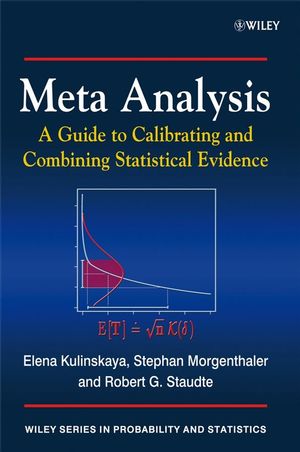Meta Analysis: A Guide to Calibrating and Combining Statistical EvidenceISBN: 978-0-470-02864-3
Paperback
282 pages
April 2008
 This is a Print-on-Demand title. It will be printed specifically to fill your order. Please allow an additional 10-15 days delivery time. The book is not returnable.
|
||||||
Part I The Methods.
1 What can the reader expect from this book?
1.1 A calibration scale for evidence.
1.2 The efficacy of glass ionomer versus resin sealants for prevention of caries.
1.3 Measures of effect size for two populations.
1.4 Summary.
2 Independent measurements with known precision.
2.1 Evidence for one-sided alternatives.
2.2 Evidence for two-sided alternatives.
2.3 Examples.
3 Independent measurements with unknown precision.
3.1 Effects and standardized effects.
3.2 Paired comparisons.
3.3 Examples.
4 Comparing treatment to control.
4.1 Equal unknown precision.
4.2 Differing unknown precision.
4.3 Examples.
5 Comparing K treatments.
5.1 Methodology.
5.2 Examples.
6 Evaluating risks.
6.1 Methodology.
6.2 Examples.
7 Comparing risks.
7.1 Methodology.
7.2 Examples.
8 Evaluating Poisson rates.
8.1 Methodology.
8.2 Example.
9 Comparing Poisson rates.
9.1 Methodology.
9.2 Example.
10 Goodness-of-fit testing.
10.1 Methodology.
10.2 Example.
11 Evidence for heterogeneity of effects and transformed effects.
11.1 Methodology.
11.2 Examples.
12 Combining evidence: fixed standardized effects model.
12.1 Methodology.
12.2 Examples.
13 Combining evidence: random standardized effects mode.
13.1 Methodology.
13.2 Example..
14 Meta-regression.
14.1 Methodology.
14.2 Commonly encountered situations.
14.3 Examples.
15 Accounting for publication bias.
15.1 The downside of publishing.
15.2 Examples.
Part II The Theory.
16 Calibrating evidence in a test.
16.1 Evidence for one-sided alternatives.
16.2 Random p-value behavior.
16.3 Publication bias.
16.4 Comparison with a Bayesian calibration.
16.5 Summary.
17 The basics of variance stabilizing transformations.
17.1 Standardizing the sample mean.
17.2 Variance stabilizing transformations.
17.3 Poisson model example.
17.4 Two-sided evidence from one-sided evidence.
17.5 Summary.
18 One-sample binomial tests.
18.1 Variance stabilizing the risk estimator.
18.2 Confidence intervals for p.
18.3 Relative risk and odds ratio.
18.4 Confidence intervals for small risks p.
18.5 Summary.
19 Two-sample binomial tests.
19.1 Evidence for a positive effect.
19.2 Confidence intervals for effect sizes.
19.3 Estimating the risk difference.
19.4 Relative risk and odds ratio.
19.5 Recurrent urinary tract infections.
19.6 Summary.
20 Defining evidence in t-statistics.
20.1 Example.
20.2 Evidence in the Student t-statistic.
20.3 The Key Inferential Function for Student’s model.
20.4 Corrected evidence.
20.5 A confidence interval for the standardized effect.
20.6 Comparing evidence in t- and z-tests.
20.7 Summary.
21 Two-sample comparisons.
21.1 Drop in systolic blood pressure.
21.2 Defining the standardized effect.
21.3 Evidence in the Welch statistic.
21.4 Confidence intervals for d.
21.5 Summary.
22 Evidence in the chi-squared statistic.
22.1 The noncentral chi-squared distribution.
22.2 A vst for the noncentral chi-squared statistic.
22.3 Simulation studies.
22.4 Choosing the sample size.
22.5 Evidence for l > l0.
22.6 Summary.
23 Evidence in F-tests.
23.1 Variance stabilizing transformations for the noncentral F.
23.2 The evidence distribution.
23.3 The Key Inferential Function.
23.4 The random effects model.
23.5 Summary.
24 Evidence in Cochran’s Q for heterogeneity of effects.
24.1 Cochran’s Q: the fixed effects model.
24.2 Simulation studies.
24.3 Cochran’s Q: the random effects model.
24.4 Summary.
25 Combining evidence from K studies.
25.1 Background and preliminary steps.
25.2 Fixed standardized effects.
25.3 Random transformed effects.
25.4 Example: drop in systolic blood pressure.
25.5 Summary.
26 Correcting for publication bias.
26.1 Publication bias.
26.2 The truncated normal distribution.
26.3 Bias correction based on censoring.
26.4 Summary.
27 Large-sample properties of variance stabilizing transformations.
27.1 Existence of the variance stabilizing transformation.
27.2 Tests and effect sizes.
27.3 Power and efficiency.
27.4 Summary.
References.
Index.



